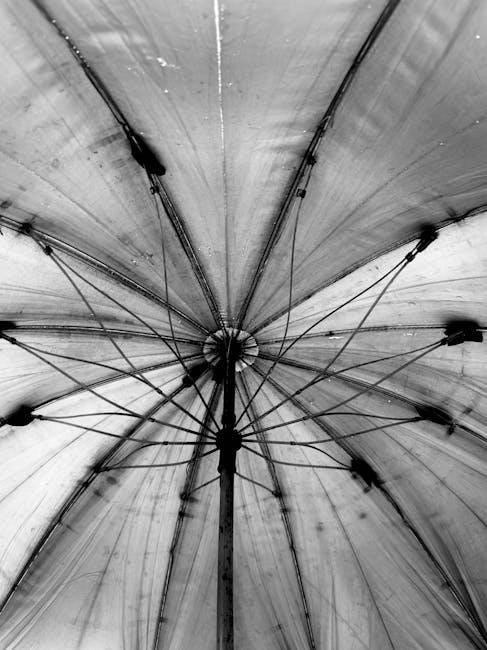Manual reclining refers to a mechanism allowing users to adjust their seating position for comfort. It is a popular feature in furniture, promoting relaxation and wellness through customizable support.
1.1 What is Manual Reclining?
Manual reclining is a mechanism that allows users to adjust their seating position by manually operating a handle, lever, or other simple controls. This feature is commonly found in chairs, sofas, and car seats, enabling individuals to customize their comfort by tilting back, adjusting the footrest, or changing the angle of the seat. Unlike power reclining systems, manual reclining relies on physical effort rather than electricity, making it a cost-effective and energy-efficient solution. The mechanism typically involves a system of gears and levers that respond to the user’s input, providing a smooth transition between positions. Manual reclining is valued for its simplicity, reliability, and ease of use, making it a popular choice for everyday furniture. Its functionality is rooted in basic mechanical principles, ensuring durability and minimal maintenance over time.
1.2 Importance of Manual Reclining
Manual reclining plays a significant role in enhancing comfort and promoting physical well-being. By allowing users to adjust their seating position, it helps maintain proper posture, reduce muscle strain, and alleviate back pain. This feature is particularly beneficial for individuals who spend extended periods sitting, as it encourages movement and prevents stiffness. Manual reclining is also cost-effective, as it eliminates the need for electric components, reducing both initial and maintenance costs. Its simplicity ensures reliability and longevity, making it a practical choice for various settings, from homes to offices. Additionally, manual reclining offers customization, enabling users to tailor their seating experience to their specific needs, thereby improving overall satisfaction and quality of life.

Benefits of Manual Reclining
Manual reclining offers enhanced comfort, improved posture, and reduced muscle strain. It provides customizable support, making it ideal for relaxation, work, and leisure, catering to diverse needs effectively.
2.1 Physical Health Benefits
Manual reclining chairs offer numerous physical health benefits, including improved posture, reduced muscle strain, and enhanced ergonomics. By adjusting the chair to a comfortable position, users can align their spine properly, minimizing the risk of back pain. The reclining feature also distributes body weight evenly, relieving pressure points and promoting better blood circulation. This can be particularly beneficial for individuals with chronic pain or mobility issues. Additionally, manual reclining fosters relaxation, which can lower stress levels and contribute to overall well-being. Regular use of such chairs can prevent long-term musculoskeletal problems and create a healthier sitting experience.
2.2 Enhanced Comfort and Relaxation
Manual reclining chairs are designed to provide exceptional comfort and relaxation by allowing users to customize their seating position. The ability to adjust the chair’s angle ensures proper support for the neck, back, and legs, reducing discomfort during long periods of sitting. This feature is particularly beneficial for individuals who enjoy reading, working, or simply unwinding. The reclining mechanism also promotes better alignment of the body, which can lead to a more restful and rejuvenating experience. Additionally, the versatility of manual reclining chairs makes them ideal for various activities, whether it’s lounging in a living room or taking a break in an office setting. By prioritizing comfort, these chairs help users relax more deeply, reducing stress and enhancing overall well-being.
2.3 Cost-Effectiveness
Manual reclining chairs are a cost-effective option for those seeking comfort without the expense of advanced features. Unlike motorized recliners, manual models require less material and technology, making them more affordable. They offer excellent value for money, providing essential functionality while maintaining durability. The simplicity of their design reduces production costs, which are then passed on to consumers. Additionally, manual reclining chairs often require less maintenance and have fewer components that could break, further lowering long-term expenses. This makes them a practical choice for individuals or families on a budget who still want to enjoy the benefits of a reclining chair. Their affordability and reliability ensure that users can experience comfort and relaxation without financial strain.

How Manual Reclining Works
Manual reclining operates via a simple mechanism where users adjust their position using a lever or handle, allowing customizable comfort without complex technology effortlessly.
3.1 Mechanism of Manual Reclining
The mechanism of manual reclining involves a simple, user-controlled system to adjust the chair’s position. Typically, a lever or handle is connected to a gear or spring system, which, when activated, alters the chair’s angle. This allows the backrest and footrest to move in tandem, providing a smooth transition between upright and reclined positions. The system relies on mechanical components, such as hinges, springs, and fulcrums, to facilitate movement. By engaging the lever, users can shift their weight and adjust the chair to their preferred comfort level. This mechanical process ensures stability and control, enabling users to customize their seating experience without the need for electronic assistance.
3.2 Key Components of a Reclining System
A manual reclining system consists of several key components that work together to enable smooth, user-controlled adjustments. The primary elements include a sturdy lever or handle, which activates the reclining mechanism. This is connected to a gear system or springs that facilitate the chair’s movement. Additionally, hinges and fulcrums allow the chair to pivot and adjust its angle. The base provides stability, while the frame supports the entire structure. Other essential parts include the upholstery for comfort and a footrest mechanism for added relaxation. These components collectively ensure the chair operates smoothly, offering users a reliable and comfortable seating solution.

Types of Manual Reclining Chairs
Manual reclining chairs are available in various styles, including home, office, outdoor, and specialty designs, each tailored to meet specific comfort and functionality needs in different settings.
4.1 Home Reclining Chairs
Home reclining chairs are designed for ultimate comfort in residential settings, offering a cozy seating solution for living rooms, dens, or home theaters. These chairs typically feature sturdy frames, plush cushions, and intuitive manual reclining mechanisms that allow users to adjust their position with ease. Available in a variety of materials such as leather, fabric, or mesh, they cater to different aesthetic preferences and lifestyles. Many models include additional features like footrests, armrests, or lumbar support for enhanced relaxation. Home reclining chairs are perfect for unwinding after a long day, reading, or watching TV, blending seamlessly into any home decor while providing exceptional comfort and versatility for everyday use.
4.2 Office and Ergonomic Reclining Chairs
Office and ergonomic reclining chairs are specifically designed to provide optimal support and comfort in professional or work-from-home settings. These chairs often feature adjustable lumbar support, tilt functions, and manual reclining mechanisms to promote proper posture and reduce strain. Many models are equipped with breathable mesh or durable fabric upholstery, ensuring long-lasting comfort during extended periods of sitting. Additional features such as adjustable armrests, headrests, and footrests are common, catering to individual preferences. These chairs are ideal for enhancing productivity while minimizing the risk of back pain or fatigue. They are perfect for home offices, corporate environments, or any space requiring a balance of functionality and ergonomic design.
4.3 Outdoor and Patio Reclining Chairs
Outdoor and patio reclining chairs are designed for relaxation in open spaces, combining durability with comfort. These chairs often feature weather-resistant materials, such as UV-protected fabrics or recycled plastic, ensuring longevity in outdoor conditions. Many models include adjustable reclining mechanisms, allowing users to customize their seating position for lounging or dining. Some designs incorporate foldable frames or lightweight constructions for easy portability. Additionally, outdoor reclining chairs may come with cushions or pillows for extra comfort, while others emphasize a minimalist aesthetic to blend seamlessly with patio decor. Whether by the pool, on a deck, or in a garden, these chairs offer a practical and enjoyable way to unwind in natural settings.
4.4 Specialty Reclining Chairs

Specialty reclining chairs are tailored to meet unique needs or preferences, offering advanced features for specific purposes. These include zero-gravity chairs, which simulate weightlessness, and massage recliners with built-in vibration or heat settings. Some models are designed for gaming, featuring adjustable armrests and cooling systems for extended use. Others cater to healthcare, providing sturdy frames and medical-grade support for individuals with mobility challenges. Certain specialty chairs also incorporate innovative technologies, such as adjustable headrests, footrest extensions, or customizable lumbar support. These chairs often combine style with functionality, making them ideal for users seeking more than basic reclining capabilities. By addressing specific demands, specialty reclining chairs provide enhanced comfort and versatility for diverse lifestyles and requirements.

Maintenance and Care Tips
Regular maintenance ensures longevity and optimal performance of manual reclining chairs. Clean surfaces, lubricate moving parts, and inspect mechanisms periodically to maintain functionality and comfort over time.
5.1 Cleaning and Upholstery Care
Proper cleaning and upholstery care are essential for maintaining the appearance and durability of manual reclining chairs. Start by vacuuming the fabric or leather to remove dust and debris. For spot cleaning, use a soft cloth dampened with mild soap and water. Avoid harsh chemicals, as they may damage the material. For stubborn stains, apply a specialized fabric or leather cleaner, following the manufacturer’s instructions. Allow the upholstery to dry completely before use. Regular cleaning prevents dirt buildup and extends the chair’s lifespan. Additionally, consider applying fabric or leather protectors to repel spills and stains. Always test cleaning products on a small, inconspicuous area first to ensure compatibility.
5.2 Lubricating Moving Parts
Lubricating the moving parts of a manual reclining chair is crucial for smooth operation and longevity. Over time, hinges, springs, and mechanisms may become stiff or squeaky due to friction. Use a silicone-based lubricant, as it is non-stick and durable. Avoid oil or grease, as they can attract dust and dirt. Apply the lubricant directly to the moving joints, such as the reclining mechanism and armrest hinges. Gently wipe off any excess with a clean cloth to prevent drips. Regular lubrication ensures the chair moves effortlessly and reduces wear and tear. For best results, lubricate every 6–12 months or when you notice squeaking or resistance. This simple maintenance step keeps your chair functioning like new and enhances your overall comfort.
5.3 Adjusting and Tightening Mechanisms
Regularly adjusting and tightening the mechanisms of your manual reclining chair ensures optimal performance and safety. Over time, bolts, screws, and levers may loosen due to frequent use. Inspect the reclining handle, pivot points, and base connections periodically. Use an Allen wrench or screwdriver to tighten any loose components. For chairs with adjustable tension, follow the manufacturer’s instructions to set the desired firmness. Avoid over-tightening, as this could damage the mechanism or restrict movement. Check and adjust these parts every 3–6 months or when you notice instability. Proper maintenance prevents wobbling and ensures smooth reclining functionality, extending the chair’s lifespan and providing consistent comfort.

Factors to Consider When Buying a Manual Reclining Chair
Manual reclining chairs offer comfort and support, but choosing the right one requires considering ergonomics, material quality, and space requirements to ensure durability and proper fit.
6.1 Ergonomics and Support
Ergonomics and support are critical when selecting a manual reclining chair. Look for features like adjustable lumbar support, headrests, and footrests to ensure proper posture and alignment. The chair should accommodate your body size and weight, offering adequate cushioning and a sturdy frame. Consider the seat height, depth, and armrest adjustability to promote comfort and reduce strain on muscles. A well-designed ergonomic chair can prevent long-term health issues, such as back pain or poor circulation. Prioritize chairs with breathable materials and a reclining mechanism that allows for natural movement. Ensuring the chair aligns with your specific needs enhances both comfort and overall well-being, making it a worthwhile investment for daily use.
6.2 Material and Durability
Material and durability are essential factors to consider when purchasing a manual reclining chair. High-quality materials, such as solid hardwood frames or durable metal alloys, ensure longevity and stability. Upholstery options like leather, fabric, or synthetic materials vary in maintenance needs and comfort levels. Look for chairs with sturdy stitching, reinforced joints, and a weight capacity that suits your needs. Durable components, such as heavy-duty springs and mechanisms, are crucial for withstanding frequent use. Additionally, consider the finish and resistance to wear and tear, as these factors impact the chair’s appearance and performance over time. Investing in a well-crafted chair made from reliable materials ensures years of reliable service and comfort.
6.3 Size and Space Requirements
When selecting a manual reclining chair, consider the size and space requirements to ensure it fits comfortably in your room. Measure the available space, including the chair’s dimensions when fully reclined. Compact designs are ideal for smaller areas, while larger chairs may suit spacious rooms. Additionally, consider the chair’s weight capacity and how it aligns with your needs. The chair’s proportions should complement the user’s height and body frame for optimal comfort. Balancing size with functionality is key to creating a practical and inviting environment. Ensure the chair’s footprint matches your room’s layout without compromising on comfort or support.

A Guide to Using a Manual Reclining Chair
Learn how to use a manual reclining chair effectively by adjusting positions smoothly, ensuring safety, and maximizing comfort for a relaxing experience tailored to your needs.
7.1 How to Recline Safely and Effectively
Start by ensuring the chair is on a stable, flat surface and clear of obstacles. Slowly activate the reclining mechanism, avoiding sudden movements. Keep your body centered to maintain balance. Adjust the footrest or leg support to a comfortable height, ensuring your feet are flat or resting securely. Avoid overreclining, as it may compromise stability. If adjusting while seated, use the armrests for support. Always return to the upright position gradually to avoid jerking. For optimal comfort, align the chair’s backrest with your natural spine curvature. By following these steps, you can enjoy a safe and relaxing reclining experience tailored to your needs.
7.2 Adjusting the Chair to Your Needs
Adjusting a manual reclining chair involves customizing its features to suit your body and preferences. Begin by setting the seat height to ensure your feet rest flat on the floor or footrest. Tilt the backrest to support your natural spine alignment, providing adequate lumbar and neck support. Use the armrests to relieve shoulder strain by positioning them at elbow height. For reclining, slowly lean back and adjust the angle until you feel comfortable. Experiment with the footrest height to avoid pressure on the legs. Regularly tweak these settings to accommodate different activities, such as reading or napping. Proper adjustment ensures optimal comfort, reduces muscle strain, and enhances overall relaxation.
7.3 Tips for Maximum Comfort
To achieve maximum comfort with a manual reclining chair, consider several key strategies. First, ensure proper posture alignment by adjusting the chair to support your spine naturally. Use cushions or pillows to fill gaps and provide extra support for your neck or lumbar region. Experiment with different reclining angles to find the most relaxing position for your body. Additionally, take breaks to stand and stretch, as prolonged sitting can lead to stiffness. Regularly inspect and maintain the chair’s mechanisms to ensure smooth operation. Finally, personalize your experience by incorporating elements like blankets, side trays, or a footrest for added convenience. These tips help maximize comfort and create a tailored seating experience.

Troubleshooting Common Issues
Identify and resolve common issues with manual reclining chairs to ensure optimal functionality and longevity. Address problems like stuck mechanisms, wobbly bases, or broken parts promptly for seamless performance.
8.1 Fixing a Stuck Reclining Mechanism
A stuck reclining mechanism can hinder the chair’s functionality. Start by inspecting for dirt or grime accumulation, which often causes friction. Clean the moving parts thoroughly using a soft brush or cloth. Apply a silicone-based lubricant to hinges and joints to reduce friction. Gently rock the chair back and forth to loosen the mechanism. If it remains stuck, check for misaligned or bent components and adjust them carefully. Avoid using force, as it may damage the chair. Regular lubrication and maintenance can prevent such issues. Ensuring smooth operation requires patience and proper technique.
8.2 Addressing a Wobbly Base
A wobbly base can compromise the stability and comfort of a manual reclining chair. To fix this, start by checking the floor surface. Ensure it is even and level, as an uneven floor can cause instability. If the issue persists, inspect the chair’s base for loose screws or bolts and tighten them firmly. For chairs with adjustable legs, consider leveling them using leg levelers or felt pads. In some cases, the base may have weakened over time. Applying wood glue or reinforcing brackets can stabilize the structure. Regularly checking and maintaining the base ensures long-term durability and prevents further wobbling. Addressing this issue promptly enhances both safety and comfort while extending the chair’s lifespan.
8.3 Repairing or Replacing Broken Parts
Broken parts on a manual reclining chair can hinder its functionality and comfort. Start by identifying the damaged component, whether it’s a handle, spring, or hinge. For minor issues, such as loose screws or worn-out washers, tightening or replacing them can resolve the problem. More severe damage may require disassembling the chair to access the broken part. If a part is beyond repair, consider sourcing a replacement from the manufacturer or a hardware store. When reassembling, ensure all components are securely fastened. Regular inspections can help prevent future breakages. Addressing broken parts promptly restores the chair’s performance and extends its lifespan, ensuring optimal comfort and safety for the user.

Manual reclining chairs offer a perfect blend of comfort, functionality, and durability, striking a balance between traditional design and modern needs. They remain a timeless choice for relaxation and lifestyle, offering unparalleled support and style.
9.1 Final Thoughts on Manual Reclining
Manual reclining chairs are a timeless solution for comfort and relaxation, blending simplicity with functionality. Their ease of use and versatility make them ideal for various settings, from homes to offices. By offering customizable support and promoting proper posture, they cater to diverse needs. Whether for unwinding after a long day or enhancing productivity, manual reclining chairs deliver exceptional value. Their durability and cost-effectiveness ensure long-term satisfaction, making them a practical investment. As lifestyles evolve, manual reclining chairs continue to adapt, providing a perfect balance of comfort, style, and practicality for everyday use.
9.2 The Future of Manual Reclining Technology
The future of manual reclining technology is poised for innovation, blending tradition with modern advancements. Expect smarter designs integrating smart sensors and AI to anticipate user preferences, offering personalized comfort. Sustainable materials and eco-friendly manufacturing processes will likely dominate, aligning with global environmental goals. Advances in ergonomics will prioritize health, with chairs adapting to diverse body types and needs. The integration of technology, such as adjustable heat or massage functions, could enhance user experience without compromising the simplicity of manual controls. As lifestyles evolve, manual reclining chairs will continue to adapt, ensuring they remain a practical and desirable choice for comfort and relaxation in a fast-paced world.

